“The best way to predict the future is to invent it,” said Alan Kay. This quote perfectly captures the essence of how AI agents are reshaping modern living spaces. Homes are no longer just physical structures; they are evolving into intelligent ecosystems that adapt to daily needs.
AI agents act as digital brains, managing everything from lighting to temperature control. For instance, smart thermostats like Ecobee can reduce energy use by up to 23%, while Google Nest learns preferences to optimize heating and cooling schedules1. These innovations not only enhance comfort but also contribute to significant energy savings.
Voice assistants like Amazon Alexa and Google Assistant are compatible with numerous devices, offering seamless control over lights, security cameras, and more2. Such advancements make daily routines effortless, turning futuristic dreams into tangible realities.
This guide explores how AI agents are transforming homes, offering insights into their benefits and practical applications. Whether you’re a homeowner or a tech enthusiast, discover how these technologies can elevate your living experience.
Key Takeaways
- AI agents optimize energy use, reducing bills by up to 30%3.
- Smart thermostats like Ecobee and Nest enhance comfort and efficiency1.
- Voice assistants integrate with multiple devices for seamless control2.
- AI-driven security systems minimize false alarms by 50%2.
- Smart homes adapt to user patterns, improving daily convenience1.
Introduction to AI-Driven Smart Homes

Modern homes are no longer just physical spaces; they’re becoming intelligent ecosystems. These systems use advanced technologies to enhance daily living, making routines smoother and more efficient.
What Are AI Agents in Home Automation?
AI agents act as digital assistants, managing everything from lighting to security. They learn user habits and adjust settings to match preferences. For example, smart thermostats optimize heating and cooling schedules, saving energy by up to 30%4.
Voice-activated systems like Amazon Alexa and Google Assistant are integrated with over 30,000 devices, offering seamless control5. These tools make it easy for anyone, regardless of technical skills, to manage their living spaces.
Benefits of Using AI in Smart Living
One major advantage is convenience. AI systems automate tasks like turning off lights or adjusting temperatures, freeing up time for users. They also enhance security by reducing false alarms by 50%5.
Energy efficiency is another key benefit. Smart lighting systems can cut electricity use by 30%, while AI-managed renewable energy sources improve efficiency by 25%5. These features not only save money but also reduce environmental impact.
As the global market for these technologies grows, it’s clear that smart home systems are here to stay. By 2025, 75% of households are expected to have at least one smart device5.
For more insights on how AI is transforming living spaces, visit this detailed guide.
Understanding the Role of AI Agents in Home Automation
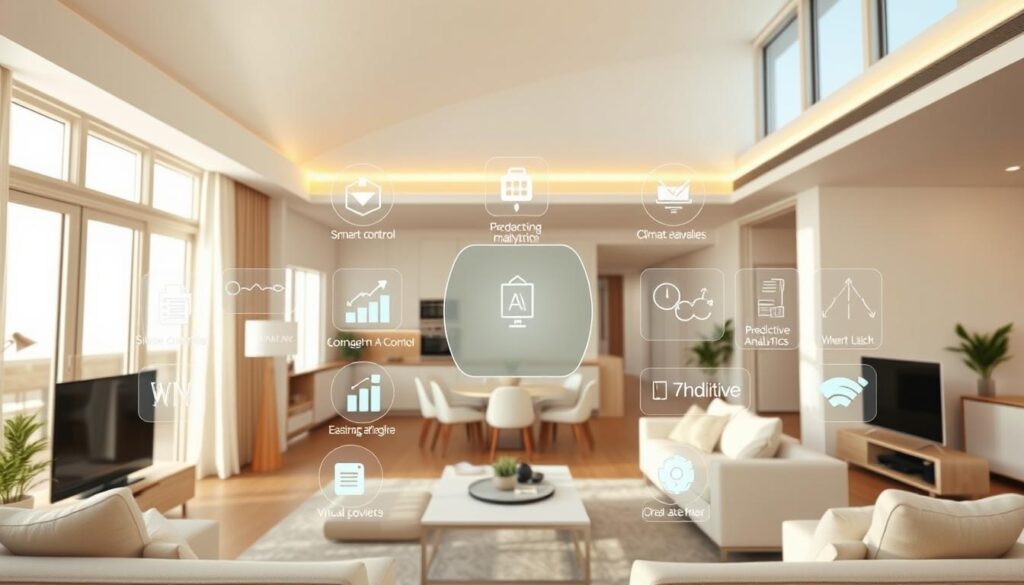
Living spaces are now powered by intelligent, adaptive systems. These technologies rely on advanced components to make daily routines smoother and more efficient. From interpreting voice commands to automating tasks, these systems are transforming how we interact with our environments.
Machine Learning and Natural Language Processing
Machine learning algorithms enable these systems to learn user habits and preferences. For example, smart thermostats adjust heating schedules based on daily routines, improving energy efficiency by up to 30%6. Natural language processing makes interactions intuitive, allowing users to control devices with simple voice commands.
These technologies continuously improve system performance. They analyze data to predict needs, ensuring seamless automation. This adaptability enhances user satisfaction and operational effectiveness.
Interconnected Devices and Sensor Technologies
Interconnected devices form the backbone of a cohesive smart home network. Sensors monitor environmental conditions, triggering actions like adjusting lighting or temperature. For instance, motion sensors can turn off lights in unoccupied rooms, saving energy7.
These systems communicate in real-time, creating a responsive and efficient environment. Sensor technologies play a crucial role in monitoring and adapting to user needs. This interconnectedness ensures that every device works harmoniously to enhance comfort and convenience.
“The future of living lies in systems that anticipate and adapt to our needs.”
By leveraging these technologies, homes become more than just physical spaces. They evolve into intelligent ecosystems that prioritize efficiency, comfort, and security. The integration of machine learning, natural language processing, and sensor technologies is driving this transformation, making smart living a reality for many.
The Integration of AI Agents in Smart Home Technologies
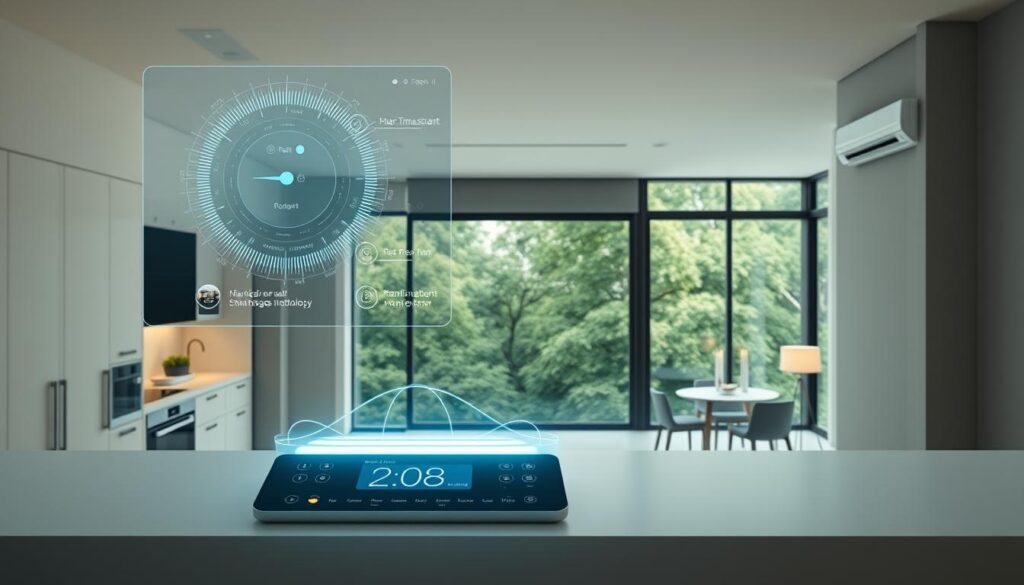
Advancements in technology are reshaping how we interact with our living spaces. Intelligent systems are now at the core of modern homes, making daily routines smoother and more efficient. These systems use automation to manage tasks like lighting, temperature, and security, adapting to user preferences seamlessly8.
One key feature is the use of natural language processing. This allows users to control devices effortlessly through voice commands. For example, saying “Turn off the lights” triggers an immediate response, making interactions intuitive and hassle-free9.
Machine learning plays a vital role in personalizing these experiences. Systems learn from user behavior, adjusting settings to match individual routines. Predictive data ensures that homes are always comfortable and energy-efficient8.
These technologies also enhance safety. For instance, security systems can distinguish between normal and suspicious activities, reducing false alarms by 90%10. This level of precision ensures peace of mind for homeowners.
“The future of living lies in systems that anticipate and adapt to our needs.”
The transition from manual to fully automated setups is transforming modern homes. By 2025, 75% of households are expected to have at least one smart device, reflecting the growing demand for these innovations10. This shift not only improves convenience but also contributes to significant energy savings, reducing consumption by up to 30%8.
With these advancements, homes are becoming more than just physical spaces. They are evolving into intelligent ecosystems that prioritize efficiency, comfort, and security. The integration of automation, natural language processing, and machine learning is driving this transformation, making smart living a reality for many.
Enhancing Efficiency and Convenience in Smart Homes
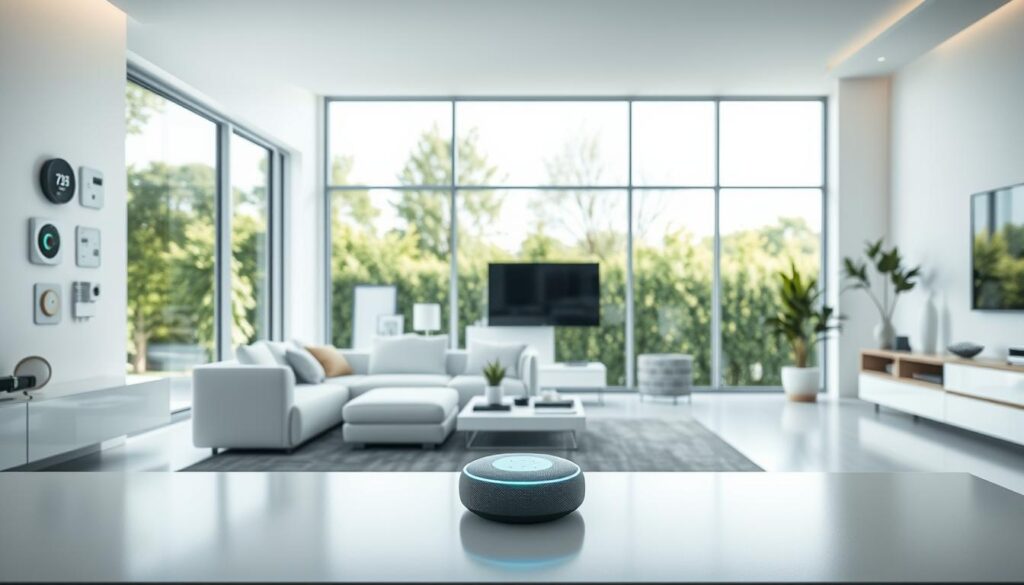
Efficiency and convenience are now at the forefront of modern living. Intelligent systems are transforming how we manage energy and daily tasks, making homes more responsive to our needs. These advancements not only simplify routines but also contribute to significant cost savings and environmental benefits.
Optimizing Energy Use and Automation
One of the most impactful features of these systems is their ability to optimize energy use. For example, smart thermostats like Nest learn user behavior and adjust heating or cooling schedules, saving homeowners an average of $180 annually11. Automated lighting systems can reduce electricity consumption by up to 30%, turning off lights in unoccupied rooms12.
These technologies also manage renewable energy sources more effectively. Smart glass, such as View Smart Windows, automatically tints based on light levels, reducing the need for traditional window coverings and enhancing energy efficiency12. Such innovations ensure that homes are not only comfortable but also eco-friendly.
Streamlined Daily Living with Predictive Triggers
Predictive triggers are another game-changer. Systems like Josh.ai analyze user behavior over time, automating tasks such as dimming lights at sunset or playing music in the evening12. This level of personalization makes daily routines effortless and tailored to individual preferences.
Voice-activated assistants like Amazon Alexa further enhance convenience. They allow users to control multiple devices with simple commands, such as adjusting thermostats or locking doors13. These features not only save time but also reduce energy waste by ensuring devices are only active when needed.
“The future of living lies in systems that anticipate and adapt to our needs.”
By leveraging these technologies, homes become more than just physical spaces. They evolve into intelligent ecosystems that prioritize efficiency, comfort, and sustainability. The benefit of such systems is clear: they make life easier while contributing to long-term cost savings and environmental gains11.
Boosting Security with Autonomous AI Agents
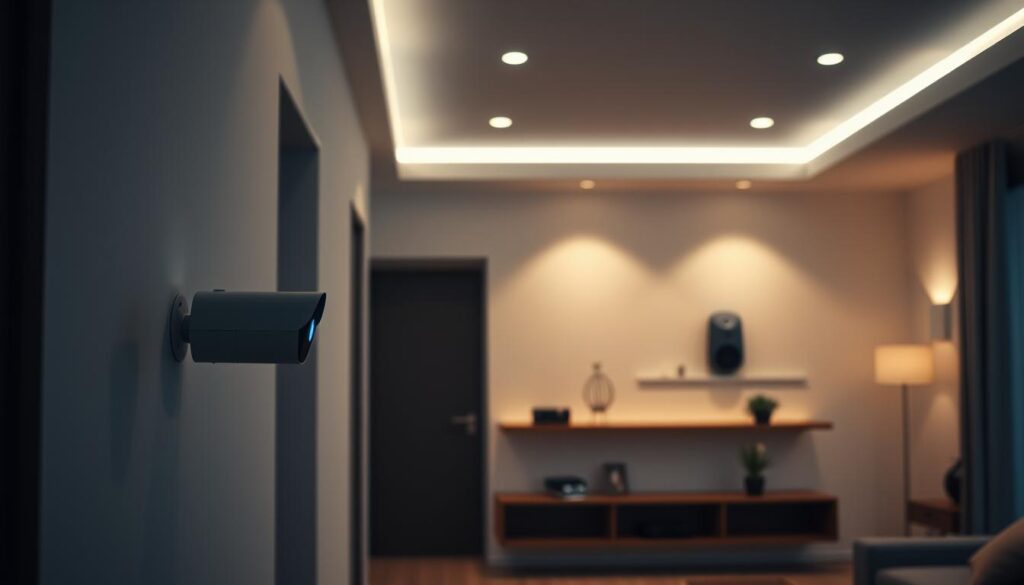
Security is no longer just about locks and alarms; it’s about intelligent systems that anticipate threats. These systems use advanced technologies to monitor and respond to potential dangers, ensuring homes are safer than ever.
Real-Time Monitoring and Emergency Responses
Autonomous AI agents provide continuous surveillance, analyzing real-time video to detect suspicious behavior. They can identify faces or objects with high precision, improving response times to potential threats14.
In emergencies, these systems automatically contact services and initiate safety protocols. For example, smart surveillance cameras can distinguish between familiar and unknown faces, reducing false alarms by 50%15.
Advanced Safety Features and Alerts
AI-driven safety features like automated door locks and alarms work cohesively to protect homes. These systems can predict security risks by analyzing patterns over time, highlighting potential threats before incidents occur14.
Users have full control over their data, ensuring privacy while maintaining security. The integration of AI and sensor technologies enhances operational efficiency, processing vast amounts of data in real-time14.
“The future of security lies in systems that anticipate and adapt to our needs.”
By leveraging these technologies, homes become more than just physical spaces. They evolve into intelligent ecosystems that prioritize safety, efficiency, and peace of mind. For more insights on how AI is transforming security, visit this detailed guide.
Step-by-Step Guide to Implementing AI in Your Home
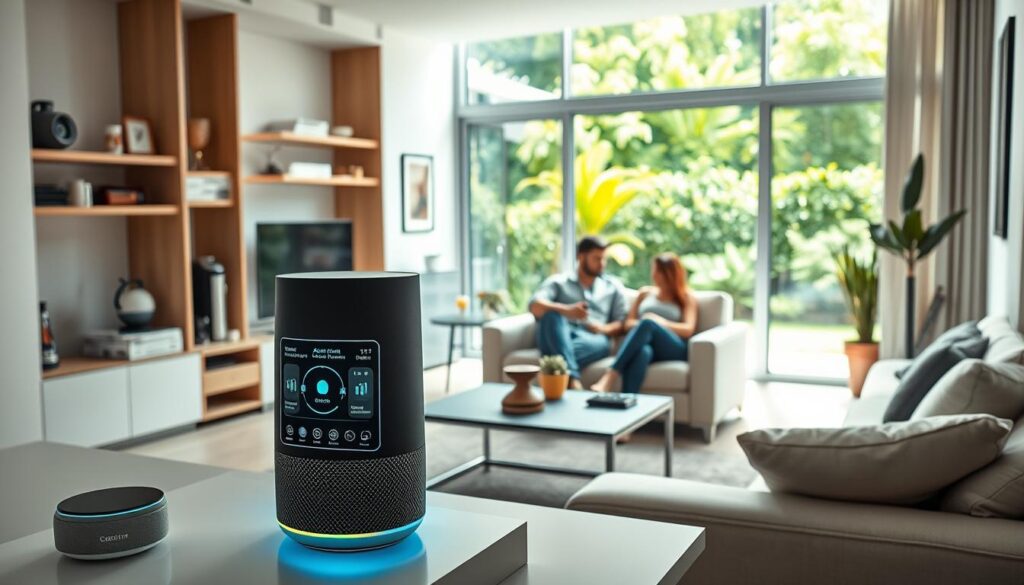
Transforming your living space into an intelligent environment starts with the right setup. Homeowners eager to embrace advanced technologies can follow this guide to ensure a seamless transition. From selecting the right ecosystem to configuring devices, each step is crucial for optimal performance.
Selecting the Right Smart Ecosystem
Choosing the right ecosystem is the foundation of a connected home. Compatibility is key, as devices need to work together seamlessly. Popular options like Amazon Alexa and Google Assistant support over 30,000 devices, ensuring flexibility for homeowners16.
Consider user needs when making a choice. For instance, those prioritizing energy efficiency might opt for systems compatible with smart thermostats like Nest or Ecobee. These devices can reduce energy consumption by up to 30%, making them a smart investment17.
Configuring Networks and Devices
Proper configuration ensures devices communicate effectively. Start by setting up a robust network to handle multiple connections. A strong Wi-Fi signal is essential for smooth operation, especially in larger homes.
Follow manufacturer guidelines during installation. For example, smart security cameras should be placed strategically to maximize coverage. Proper placement reduces false alarms by 50%, enhancing overall security16.
Synchronization is critical for automation. Devices like smart lights and thermostats should work in harmony to create a cohesive experience. Voice commands can simplify control, allowing homeowners to manage their homes effortlessly.
“The future of living lies in systems that anticipate and adapt to our needs.”
Post-installation, monitor the system regularly. Updates ensure devices remain secure and functional. By following these steps, homeowners can enjoy a smarter, more efficient lifestyle.
Leveraging Personalized Automation Experiences

Personalized automation is redefining how we interact with our living spaces. Advanced systems now adapt to individual habits, offering tailored experiences that enhance daily life. These technologies learn from user behavior, creating environments that feel intuitive and responsive.
Voice-Activated Commands and Custom Routines
Voice-activated commands simplify home control, allowing users to manage devices effortlessly. For instance, saying “Dim the lights” adjusts brightness instantly, creating a cozy atmosphere. These commands integrate seamlessly with daily routines, making interactions smooth and natural18.
Custom routines adjust settings based on individual preferences. Lighting scenes can change with the time of day, while temperature settings adapt to personal comfort levels. This level of personalization ensures homes are always welcoming and efficient19.
These systems also predict needs, enhancing convenience. For example, smart thermostats learn schedules, optimizing heating and cooling without manual input. Such features not only save energy but also improve user satisfaction20.
“The future of living lies in systems that anticipate and adapt to our needs.”
The power of integration lies in its ability to create seamless experiences. Devices work together harmoniously, offering a cohesive environment that prioritizes comfort and efficiency. As technology evolves, these systems will continue to enhance daily life, making personalized automation an essential part of modern living.
Integrating AI with Existing Home Automation Systems
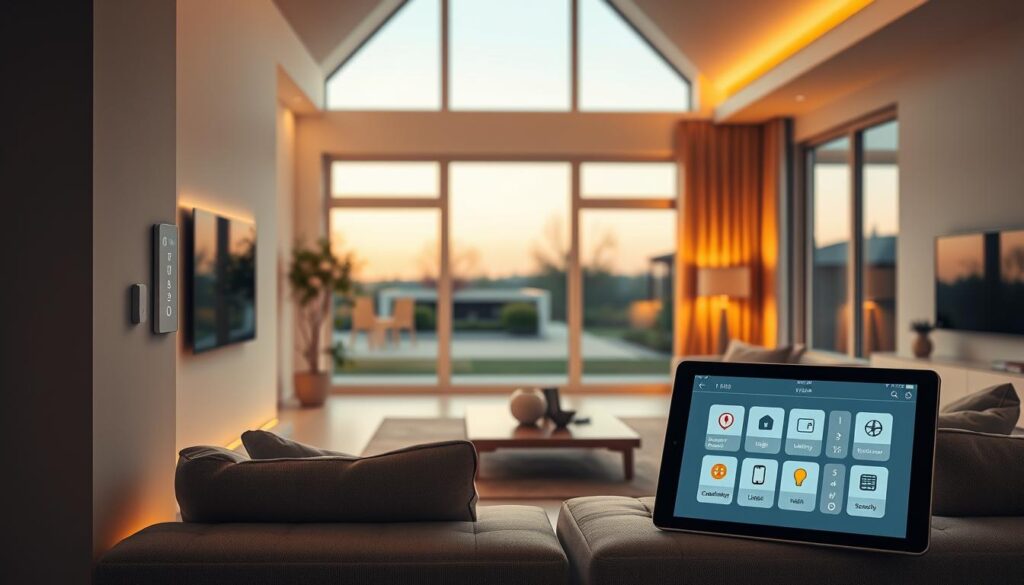
The seamless integration of advanced technologies into everyday living spaces is revolutionizing how we interact with our environments. For homeowners, ensuring compatibility and smooth communication between devices is key to a seamless experience.
Ensuring Compatibility and Seamless Communication
Compatibility standards are essential for a cohesive smart home setup. Devices from different brands must work together effortlessly. Leading platforms like Google Assistant and Amazon Alexa support over 30,000 devices, making them ideal for diverse setups21.
Seamless communication enhances the experience by allowing devices to share data in real-time. For example, smart thermostats can adjust settings based on lighting or occupancy, improving energy efficiency by up to 30%22.
Updating legacy systems is crucial for accommodating new technologies. Older devices may require firmware updates or replacements to ensure they function within modern ecosystems. This process saves time and prevents potential disruptions.
Voice interfaces play a pivotal role in unifying different technologies. Commands like “Turn off the lights” or “Lock the doors” simplify control, making interactions intuitive and efficient21.
Challenges like system failures or data privacy concerns can arise. However, brands like Google and Amazon offer solutions, such as encrypted communication and regular updates, to address these issues22.
“The future of living lies in systems that anticipate and adapt to our needs.”
By following best practices, homeowners can ensure smooth transitions during updates and integrations. This approach not only enhances convenience but also maximizes the benefits of a connected home.
SmythOS: Advancing AI Development for Smarter Homes
Developers now have powerful tools to create smarter living environments. SmythOS stands out as a cutting-edge platform designed to streamline home automation development. It offers advanced features that simplify complex integrations, making it easier to build intelligent systems.
Visual Debugging and Monitoring Capabilities
SmythOS provides a robust visual debugging environment. This feature allows developers to troubleshoot issues quickly, ensuring smooth operation of home automation systems. Real-time monitoring helps track performance metrics like accuracy and precision, which are crucial for optimal functionality23.
With these tools, developers can identify and resolve problems before they impact users. This proactive approach enhances the overall convenience and reliability of smart home solutions.
Enterprise-Grade Security and Scalability
Security is a top priority for SmythOS. The platform includes enterprise-grade features that protect user data and system integrity. Advanced encryption and compliance standards ensure that home automation systems remain secure from potential threats24.
Scalability is another key advantage. SmythOS can manage growing needs, from small setups to large-scale deployments. This flexibility makes it an ideal choice for developers aiming to create future-proof solutions.
“The future of living lies in systems that anticipate and adapt to our needs.”
By leveraging SmythOS, developers can build smarter, more efficient homes. The platform’s focus on intelligence and convenience ensures that users enjoy seamless and secure experiences.
Addressing Challenges and Considerations in AI Integration
Navigating the complexities of advanced systems requires addressing key challenges head-on. While these technologies offer numerous benefits, they also come with hurdles that need careful attention. From data privacy to compatibility issues, understanding these obstacles is essential for a seamless experience.
Data Privacy, Security, and Compliance
One of the most pressing concerns is data privacy. Systems handle vast amounts of personal information, raising questions about how this data is stored and used25. Breaches have increased by 30% year-over-year, highlighting the need for robust security measures25.
Compliance with regulatory standards is another critical factor. Non-compliance can lead to legal repercussions and loss of public trust26. Implementing encryption and regular audits can mitigate these risks, ensuring user data remains protected27.
Managing Compatibility and Technical Issues
Compatibility issues often arise when integrating devices from different manufacturers. This can lead to a fragmented user experience, reducing the overall effectiveness of the system27. Industry standards are being developed to address this, but challenges remain.
Technical issues like system failures or high power consumption can also impact performance. Energy-efficient designs and regular updates are essential for maintaining reliability26. Leaders like Google are working on solutions to enhance interoperability and reduce complexity27.
“The future of living lies in systems that anticipate and adapt to our needs.”
By addressing these challenges, homeowners can ensure their systems are both secure and efficient. For more insights on overcoming these hurdles, visit this detailed guide.
Future Trends and Innovations in Smart Home AI
Innovation is driving the next wave of intelligent living spaces. Emerging technologies promise to make daily routines even more seamless and efficient. From advanced machine learning to intuitive control systems, the future of home automation is bright.
Emerging Technologies and Machine Learning Advances
Machine learning is set to enhance agent capabilities, enabling smarter decision-making. Predictive analytics will optimize energy use, potentially reducing consumption by up to 30%5. Voice control features are also evolving, offering hands-free convenience for tasks like adjusting light settings5.
Forecasting the Evolution of Home Automation
By 2025, 40% of households are expected to adopt AI-driven devices28. These systems will integrate seamlessly, creating cohesive ecosystems. Enhanced interface designs will simplify user interactions, making automation more accessible than ever.
For deeper insights into how AI-driven automation is transforming living spaces, explore this detailed guide. The future of home automation is here, and it’s smarter than ever.
FAQ
What are AI agents in home automation?
How do AI agents improve energy efficiency?
Can AI agents enhance home security?
What role does voice command play in smart homes?
How do AI agents handle personalized automation?
Are AI agents compatible with existing home systems?
What are the challenges of integrating AI in smart homes?
What future trends can we expect in smart home AI?
Source Links
- How to Integrate AI Solutions for Smart Home Automation?
- No title found
- AI and IoT in Smart Homes
- Smart Homes: A Technical Guide to AI Integrations – viso.ai
- AI in Home Automation: Smarter Living with AI Smart Devices
- SmythOS – Autonomous Agents in Home Automation
- AI Agents In Smart Home Automation | Restackio
- Smart Home AI Adoption Statistics | Restackio
- How I Built an Autonomous AI Agent to Run My Smart Home
- How AI for Smart Home Transforms Living Spaces
- Smart Home & Technology? The Top 10 Pros and Cons
- What’s new in smart home technology? Meet the AI revolution for luxury homes – Tech Helpline
- What is a Smart Home? Everything You Need to Know|Definition from TechTarget
- SmythOS – Autonomous Agents and Security Surveillance
- Autonomous AI Agents: Exploring Their Role
- AI Agents Revolutionizing Smart Homes 2025 | Ultimate Guide
- Build an AI Agent System: Step-by-Step Guide 2024
- AI Agents Revolutionizing UX Personalization 2024 Ultimate Guide
- How to leverage AI, automation to prevent common customer experience challenges
- The Integration of AI in Smart Homes and Offices: Creating Efficient and Personalized Environments
- AI in Smart Home Technology Market Analysis and Forecast 2024-2031
- The Role of Artificial Intelligence in Smart Home Systems | HData Systems
- SmythOS – AI Integration
- SmythOS – Digital Assistants in Smart Homes: Revolutionizing Everyday Living with AI
- Ai Challenges In Smart Home Technology 2024 | Restackio
- AI Agents & Robotic Hardware Integration: Challenges & Solutions
- No title found
- Your New Smart Home Companion – Quantilus Innovation







